Energy Innovation Program, Carbon Capture, Utilization and Storage
Call 1: Front-End Engineering Design Studies
Department of Natural Resources, Office of Energy Research and Development
Applicants' Guide for Request for Expressions of Interest, August 2021
Table of Contents
Table of Contents
1. Introduction and Call Overview
Budget 2021 proposed $319 million over seven years for innovation in Carbon Capture Utilization and Storage (CCUS). These funds will bring together businesses, academia, non-profits, industry, government, and federal laboratories on the path to net-zero emissions by 2050.
This is the first call for CCUS project proposals by the Office of Energy Research and Development (OERD) with a focus on Front-End Engineering Design studies. Future calls will be announced on the OERD Energy Innovation Program web page.
1.1 Call overview: Front End Engineering and Design (FEED) Studies
Although CCUS technologies have been deployed and demonstrated at large scale at various sites in Canada - such as the Quest and Boundary Dam projects - the application of CCUS across industry remains nascent, with a limited number of commercial scale facilities in operation globally. To ensure that CCUS technologies have an opportunity to be deployed broadly in industries that have limited options to decarbonize by 2050, more facilities need to be demonstrated at scale.
A critical and costly step in this process is completing a FEED study. Performing a FEED study helps reduce the technical and commercial risk of a project to the point where an investment decision can be made to proceed with construction. It also provides an opportunity to evaluate and benchmark near commercial technologies helping them to come to market.
2. Desired outcome(s)
This call supports FEED studies for CCUS projects that have the potential to significantly mitigate emissions. These projects are also expected to increase the knowledge base for different types of facilities, applications and technology approaches for CCUS in Canada. Completed FEED studies are expected to lead to the following broad outcomes:
- Advance engineering knowledge and experience for large CCUS capital projects including demonstrations up to first-of-a-kind commercial deployments; producing references and analyses of performance and cost for new technologies and approaches; to inform the development of next generation technology.
- Increase the likelihood that CCUS will be constructed at scale in Canada across several different industries, supporting different technologies and approaches to CO2 usage and storage.
- Increase the knowledge base of applying CCUS to industrial facilities to accelerate replications across Canada.
3. Eligible projects
This call seeks proposals for FEED studies for CCUS applied to existing facilities, new industrial facilities and, Direct Air Capture (DAC) facilities. If constructed, the CCUS project would capture at least 10 kilotonnes (kt) of CO2 per year. There will be a preference to fund FEED studies for projects that have the ambition to capture 50 kt of CO2 per year or more.
The call will support projects advancing FEED studies for demonstrations of novel CCUS technologies and first-of-kind deployment projects.
Once completed, the FEED study should be detailed enough for construction to commence, resulting in a “shovel-ready” project.
The FEED study should include all components of the CCUS value chain:
- capturing the CO2 from an industrial facility or DAC at a rate of at least 10 kt per year
- the plan for transporting the captured CO2, if relevant
- details on how the CO2 will either be permanently sequestered or used to make products
All industrial sectors are eligible, such as electric power generation, oil and gas (oil sands), cement, iron and steel, chemicals including petrochemicals, refining, hydrogen production etc.
This call supports FEED studies that expand the knowledge on how to engineer commercial scale projects. However, projects that include innovative components or help expand the CCUS knowledgebase in Canada will be preferred, which includes:
- projects that incorporate novel technologies or approaches for capture, transportation, storage or use of CO2
- projects that apply to facilities or emissions sources where CCUS has not yet been demonstrated in Canada
- projects that are in regions with no deployed CCUS or in storage geologies that have not yet been tested in Canada at a commercial scale
- FEED studies that incorporate capture technologies with high capture rates, that could be broadly applicable to multiple industrial sectors, with a variety of emissions quantities and profiles
- projects that have the potential to become CCUS hubs where in future multiple emitting facilities could leverage common infrastructure for transporting, utilizing or permanently sequestering CO2
In addition to the above, projects that have a strong plan for disseminating the knowledge gained through the FEED study to support further replications of the CCUS projects in Canada will be given preference. Dissemination of all or portions of the FEED study project will be considered (noting that portions of the project may contain proprietary IP).
FEED projects not eligible for funding are those that generally replicate commercial scale projects that have already been constructed in Canada such as the following:
- Shell Canada Energy Quest Project
- Enhance Energy – Alberta Carbon Trunk Line Carbon Capture and Storage Project
- Boundary Dam Integrated Carbon Capture and Storage Demonstration Project
Note that NRCan does not intend to fund those components of projects that include enhanced oil recovery (EOR), nor the EOR portion of the FEED study.
4. Funding & support
The Energy Innovation Program provides non-repayable contributions for eligible project activities. Please refer to section 3.5.6 of the General Guide for more information.
This call may contribute up to 50% of total project costs. It is expected that projects will request between $3,000,000 and $7,000,000.
| Minimum Program Contributions $ | Maximum Program Contributions $ | Project Life |
|---|---|---|
| $3M | $7M | Up to 3 years |
5. Eligible proponents & technologies
For eligibility criteria, please refer to the Innovation and Clean Growth Programs Terms and Conditions.
6. Application timeline and process
6.1 Application Process
The Department of Natural Resources (NRCan) is committed to a consistent, fair, and transparent project selection process to identify, select, and approve the allocation of funding to projects that best fit the program’s objectives.
For Phase 1, Expression of Interest (EOI) submission, applicants can find all information necessary to start preparing their EOIs in this guide. The call will be open for EOI submissions between August 9, 2021 and September 22, 2021 11:59 pm EDT. Applicants may contact the program should they need further clarity on expectations: nrcan.energyinnovation-innovationenergetique.rncan@canada.ca.
An applicant may withdraw their EOI at any stage of the evaluation process, by notification the Program in writing via email. Applicants must submit an EOI to be eligible for submission of a full project proposal.
EOIs will be assessed based on the criteria provided in section 3, with only the most promising projects moving on to Phase 2 – Full Project Proposal (FPP). The program may request supplementary information at various points in the review process.
Those applicants that are invited to Phase 2, submission of FPP, will receive notification of the required templates and information to be completed. The applicant must provide all mandatory information in order to be considered for funding. Please note that a request for a Full Project Proposal will not represent a funding commitment from the program.
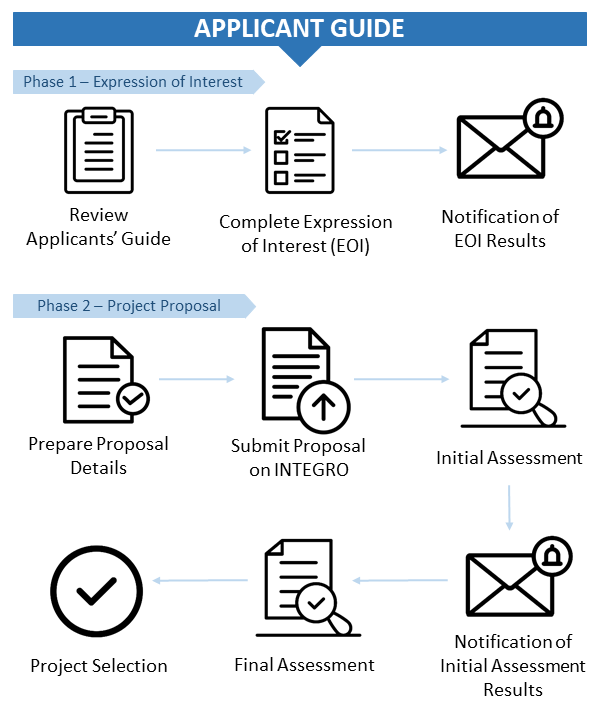
Text version
Applicant Guide: Phase 1 – Expression of Interest - review applicants’ guide, complete Expression of Interest (EOI), notification of results. Phase 2 – Full Project Proposal: prepare proposal details, submit proposal on INTEGRO, initial assessment, notification of initial assessment results, final assessment, project selection.
6.2 Application Timelines
The following timelines are anticipated for this Call. Note that NRCan, at its sole discretion, reserves the right to modify the currently anticipated timelines. Changes will be communicated to Applicants via the email address provided in the Applicant Profile during the Expression of Interest on-line application process.
| Integro open for EOI Submissions | August 9th 2021 |
|---|---|
| Due Date for Submission of EOI | September 22nd 2021 11:59 pm EDT |
| Notification of EOI results | November 2021 (estimate) |
| FPP Submission Deadline | January 2022 (estimate) |
| Final Project Selection/Notification | March 2022 (estimate) |
| Due Diligence Process | Spring 2022 (estimate) |
| Negotiating and Signing of Contribution agreements | Spring 2022 (estimate) |
6.3 EOI Preparation
When preparing an EOI, applicants will need to gather the following information:
- Applicant Information – including primary contacts, mailing address, organization information.
- Project Information – Sector, focus area, project type, project details, letter of support, project timeline(s).
- Budget & Partners – Total program amount requested, all anticipated financial and non-financial partners, federal research centre support (if applicable).
- Project Summary – Methodology, project team, alignment with scope, addressing a gap, innovativeness, uptake potential, environmental impact, economic and/or social impact.
EOIs will be evaluated based on the following:
- The alignment of the project with the stated outcomes, rationale and scope of the technical area outlined in Sections 2 and 3 of this Guide.
- The feasibility of the project, including evaluating the funding and team required to deliver the project.
- The environmental (GHG emissions reductions) and economic impacts and benefits that are expected to result from successful completion of the proposed project.
6.4 Full Project Proposal Stage
Only those applicants who are successful in the EOI stage will be invited to submit a Full Project Proposal. The Program team will follow up with these Applicants to provide guidance and instructions on completing the next steps, as well as provide any templates or documentation required.
6.5 Due Diligence Assessment
All successful Applicants passing the FPP stage will undergo a due diligence assessment, which will include an evaluation of the project’s finances, technical risk, and team risk. NRCan may request that the Applicant provide additional information to support the due diligence evaluation. All Applicants undergoing due diligence will be notified whether or not their project passes the due diligence assessment. Following due diligence assessment, Applicants whose projects pass the due diligence assessment will be invited to work with the Program to draft, sign and execute a Contribution Agreement.
6.6 Contribution Agreement
After receiving the notice of funding approval, applicants will need to enter into a Contribution Agreement with NRCan. If a Contribution Agreement cannot be finalized within a reasonable timeframe, funding may be reallocated to other projects. For more information on Contribution Agreements, please see the Innovation and Clean Growth Programs Terms and Conditions.
6.7 Reporting Requirements
After entering into a Contribution Agreement with the Program, successfully funded projects will be required to report on a quarterly and yearly basis to ensure that targets and objectives are being met. Refer to Section 3.6 of the Program Terms and Conditions for more information.
As some outcomes may only be realized after funding has ended, ongoing data collection and assessment will be required for a period of five years following the project’s completion date.
7. Information sharing permissions
During the application process, applicants will be asked whether they provide permission for NRCan to share their application with other relevant funding organizations. For projects that may not obtain funding under the program, this will allow the program to provide the opportunity for maximum exposure and guidance across other federal funding programs or providers.
7.1 The Clean Growth Hub
The Clean Growth Hub is a whole-of-government focal point for clean technology focused on supporting companies and projects, coordinating programs and tracking results. The Hub is an interdepartmental organization with member departments and agencies including: Innovation, Science and Economic Development Canada; Natural Resources Canada; Environment and Climate Change Canada; Transport Canada; Fisheries and Oceans Canada; Agriculture and Agri-Food Canada; Global Affairs Canada; the Treasury Board Secretariat of Canada; the National Research Council; Business Development Bank of Canada; Export Development Canada; Sustainable Development Technology Canada; and Canadian Commercial Corporation.
Should you consent, the information you provide may be shared across federal departments/ agencies, including but not limited to the departments and agencies represented in the Clean Growth Hub, with a view to assisting you in determining the federal programs/supports best suited to your needs. Pursuant to Paragraph 20(1) of the Access to Information Act, the Clean Growth Hub will not publicly disclose any information without permission.
7.2 Trusted Partners
To facilitate co-funding with provincial/territorial and industry funders, NRCan is working in collaboration with a network of other funding organizations across Canada. By giving NRCan the authority to share your proposal with our “Trusted Partners” (TP), you allow NRCan to explore possible co-funding opportunities, referrals, or follow-on funding opportunities. Please note that NRCan will only share these applications with TPs where NRCan has a non-disclosure agreement in place and for the purposes of referring proposals for funding consideration, or exploring the possibility of co-funding.
For more information and a list of the Program’s current Trusted Partners, please refer to Section 9 of the Innovation and Clean Growth Programs Terms and Conditions.
Appendix A - Integro User Guide
This appendix describes the steps to accessing Integro via NRCan’s eServices portal and submitting an EOI application under the Energy Innovation Program.
You can access Integro from NRCan’s eServices Portal at https://eservices.nrcan-rncan.gc.ca.

Text version
NRCan eServices Portal login page, showing the two options to log in: 1. Continue to Sign-In Partner, and 2. Continue to GCKey
If you don’t have a GCKey you will have to register for one or use the Sign-in Partner option.
To create a GCKey for your organization
- On the Welcome Page, click “Continue”
DO NOT misplace your GCKey username/password as it cannot be easily recovered!
Once signed in using your GCKey, you will see the following screen.

Text version
NRCan eServices Portal welcome page, displaying the time and date of last sign-in as well as options to change the user’s password or recovery questions.
Click ‘Continue’ to proceed to the NRCan eServices Portal.
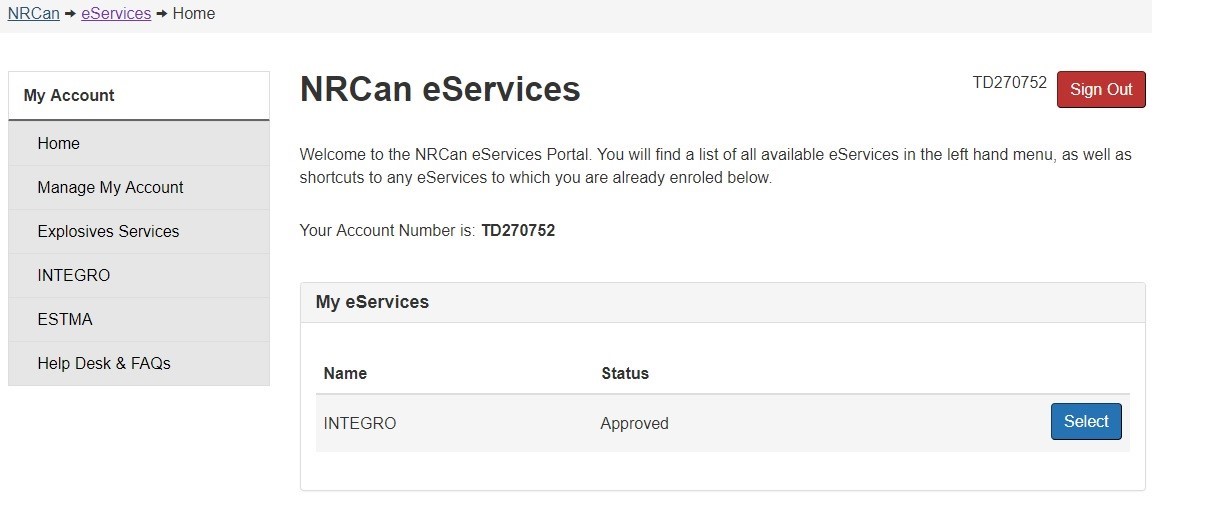
Text version
NRCan eServices Portal main page, showing the options available to users. Integro can be accessed from this page using the left-side menu or centre button.
From NRCan eServices, select Integro from the Register for Integro
- If you already have an account click “Select” Integro
- If you don’t have an account, please register for Integro
The options are as follows:
After signing in to Integro, you will see the following page:

Text version
Integro welcome page, showing the left-side menu options and a reminder to create a Client Profile if the user hasn’t already.
- Welcome
- Client Profile
- My Submissions
- Service Request
- User Information
- Help
- Logout
Return to the Integro Welcome page.
Create a new client profile, or edit an existing profile.
Start a new submission, or view an existing submission.
Request an amendment or report a technical problem.
Update your user information (i.e. email address).
View help topics related to Integro.
Log out of Integro.
If you have an Integro Client Profile from a previous application to an NRCan program, you can use that profile for your application to the EIP Program.
If you do not have an Integro Client Profile, select the Client Profile tab to create one. You MUST have a Client Profile to submit an EOI under the Energy Innovation Program.
To create a profile, select ‘Client Profile’ and click the ‘Register New Client’ button.
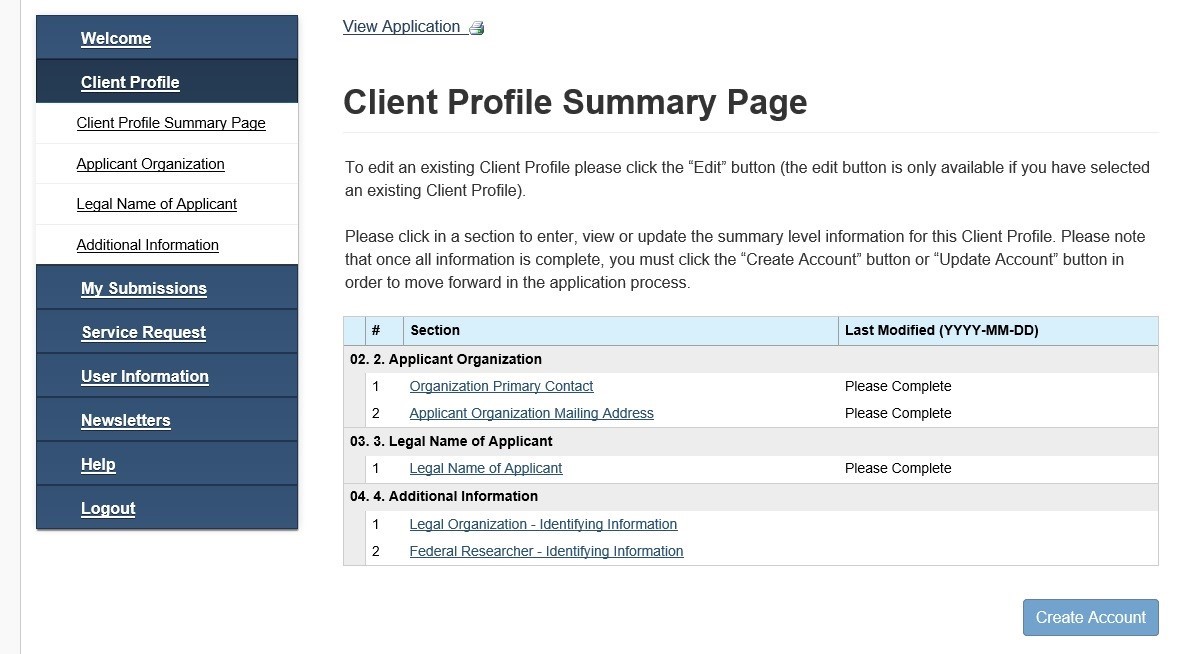
Text version
Integro Client Profile creation page, showing the instructions for completing a Client Profile.
Complete the sections of the form. Note that items marked with a red star are mandatory inputs, while the other inputs are optional and may not apply to your organisation (i.e. NAICS code). If you are unable to move between pages or submit your Profile, it most likely means you are missing one or more mandatory inputs.
The primary contact should be the lead individual responsible for the EOI application.
The Legal Name of Applicant refers to your organisation’s legal name, which may be different from its operating name.
Once all required information has been entered, click the ‘Create Account’ button to create your Client Profile. You will receive an automatic notification email once your Client Profile has been created.
Creating an EOI Application
Within Integro, select the “My Submissions” tab to go to the list of NRCan programs, and click the Folder icon in the Energy Innovation Program.
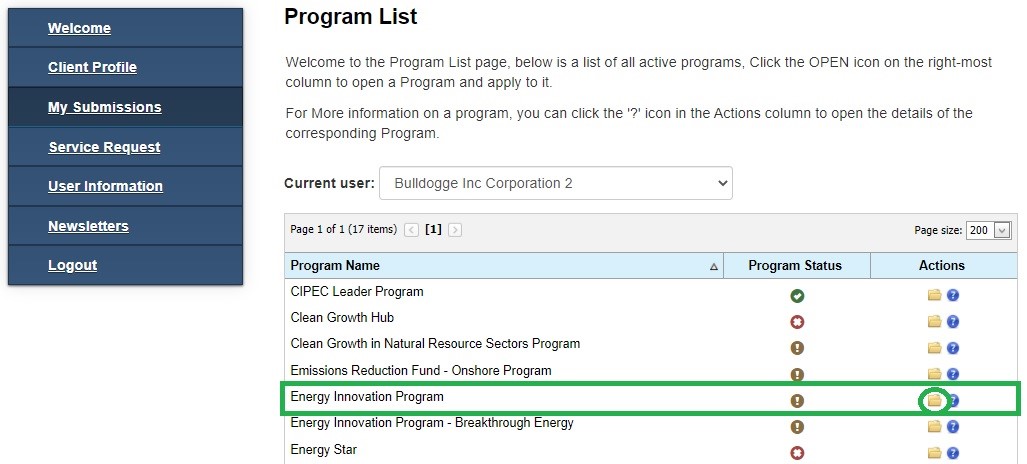
Text version
Integro Program List page, with the Energy Innovation Program option highlighted by a green box to indicate the correct program. The folder icon corresponding to the Energy Innovation program is highlighted by a green circle, indicating where to click to access submissions to the Energy Innovation Program.
Ensure you have selected the correct program by verifying that Energy Innovation Program is listed as the Current Program. From this page, you can click the New Submission button to begin your EOI Application. If you have an Application completed or in progress, it will appear in the list. The icons under ‘Actions’ allow you to edit or delete your Application.
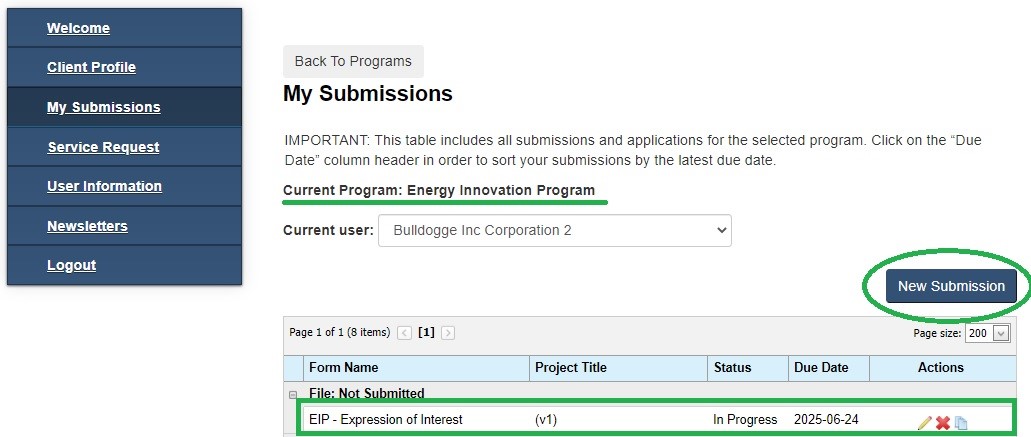
Text version
Integro Submissions page. The Current Program title is highlighted to indicate that it is showing as Energy Innovation Program, verifying that the user is looking at the correct page. An existing submission is highlighted with a green box to indicate the information that will appear on the page if the user has an EOI submission in progress. The button for New Submission is circled to highlight where a user should click to create a new EOI form.
Ensure you “Save” your work by clicking the “Save” or “Next” button. You can save a section and go back to the Application at a later date to complete it. Note that you must complete all required elements on a page to save it.
Please ensure to attach any applicable documents where indicated.
The Application must be fully complete before you can submit it. You will receive an automatic email notification when you have successfully submitted your Application.
You must complete and submit the form by the due date specified in the Applicant’s Guide.
Should you need to make changes after the Application is submitted, but before the submission deadline, you will have to request an Amendment from the Energy Innovation Program via email. If granted, the Application will be released back to you for amendment.
Appendix B – Definitions
For a list of definitions, please refer to Section 5 of the Innovation and Clean Growth Programs Terms and Conditions.
Appendix C – Expression of Interest Form Guide
Below is additional guidance for some of the questions in the Expression of Interest form in Integro.
Project Information
http://www.latlong.net can be used to find latitude and longitude coordinates.
Project Details
Current Technology Readiness Level (if applicable): It is expected that the TRL of projects will be 8, 9 or Not Applicable given these are FEED Studies only.
Planned Technology Readiness Level at end of funding: It is expected that the TRL of projects will be 8, 9 or Not Applicable given these are FEED Studies Only.
Project Pitch - Overview
Question B – Provide a detailed description of your project.
This description should focus on the specifics of the Project being engineered/designed. Describe the elements that the FEED would cover. The next questions ask about expected/desired outcomes.
Project Description - WHAT, HOW, OUTCOMES
Question C - How does this project contribute to the path to net-zero by 2050?
(e.g. What is the addressable market for your solution? How is your work going to shape the market for environmentally sustainable solutions? What is your path to scale the solution?)
Useful resources:
The Pan-Canadian Framework on Clean Growth and Climate Change
A Healthy Environment and a Healthy Economy
Question D - Describe how the project addresses a barrier / gap / need in the energy system.
E.g. technical barriers for construction of CCUS at scale. You may include projected cost per tonne of CO2 captured if the facility is built, or annual volume of carbon captured.
Question E - Briefly describe the roles, education and experience of your project team and collaborators.
Include key participants involved in the development of the FEED and the project.
Page details
- Date modified: